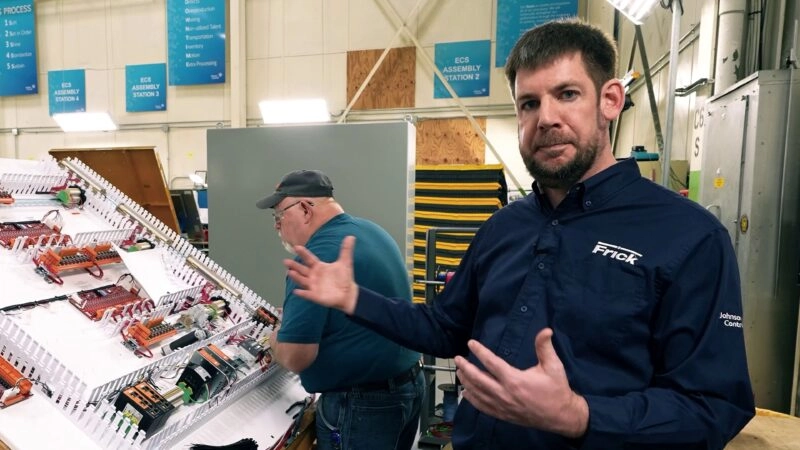AcuAir Unit Walkthrough
AcuAir units are using food processor facilities to maintain processed rooms at a temper. So very cold temperatures, pressurized, and we want to keep a humidity level optimal.
Yeah. As you can see, the Accuator unit here is in process of being built. It is a very complex unit, but it can really be broken down into modes of operation.
You have your processing mode. So while, you know, product and people are being worked on in the process space, you’re gonna be recirculating the vast majority of air.
So in this opening here, you’re gonna have your return. From the space coming in and into the unit. And as it goes through, the air will have an option. It can either be exhausted out through some exhaust fans that are mounted here, and we do that to control the room pressure into space, or it can go through a damper all the way into the mixing area. So in with that, we will actually go through the same process of cooling, reheat into the fan. And then we’ll be blowing it into the space.
The other distinct option is when we go into sanitation mode or cleanup. So instead of you know, the air from the space, it comes in to the return air opening. This far damper is closed and all the air will be going out through the exhaust fans. So all the moist and warm air is being removed from the space and exhausted. And with that, we’re actually opening up this outside air damper a hundred percent open. So, it is opening and we’re bringing in nothing but fresh air to the space itself. If you come over here, you could see Once this opens, right behind here is actually a sanitation source or sanitation heat source. And in this particular unit space, it’s a direct fire burner. So you have a burner that’s, you know, shooting flames and heating up the air.
Then it will come over into this section, and this is what we would call our pre filters and cooling section. You’re gonna have some Merve eight, you know, four inch pleated filters. So very similar to your residential furnace, the throwaway type of filters. That really will help keep this coil that’s located here free from debris.
And then we have our, you know, cooling coil section. You can see we have a triple sloping drain pan, so it’s sloped this way, this way, and that way, all going out that direction. And we can have anywhere from one coil up to three coils high in this, depending on your configuration. So any condensation that is made here in this cooling coil section can come out and is quickly removed from the space.
And this is actually just an access area for the coil itself. If you had a UV section, so if you were using UV lights to kill bacteria on the coil and within the air stream, you would have this access here. After the coil, you know, UV and access, here’s kind of the main driver to the entire unit. It’s our our giant supply fan.
And this unit is actually on the smaller side, so it only has one fan but these can go up to two to three, even four fans in some instances.
And, you know, a couple of good highlights within this, we’ve tried to reduce or minimize all of the screw heads, fasteners within this space because we want to maintain a hygienic air. Anything that has an opportunity to collect dust, condensation, and restore it, that’s a a place for bacteria to grow. What we’re really trying to do is prevent any fastener heads, any place air can be trapped. In here, we have a plenum fan, so it’s an open centrifugal style fan that is direct driven by a TESC motor.
So that means you’re able to clean this area out, spray everything down, make sure it’s clean. But what it’s doing, it is building pressure for the space and it comes through, and we are, you know, using some Merv fourteen filters on the back end here. To actually clean the air before it goes back to your processed space. So a few good highlights of what we do differently hygienically in this in this unit.
Inside the the fan section, we actually lift the fan off the floor. About twelve inches, and we have, you know, welded pedestals.
So now, you’re able to get underneath this fan and clean it without any issues. We try to maintain a very smooth wall and every section has a floor drain, floor drain or a drain pan, that allows you to get rid of the condensation or after you clean the inside of the unit, you’re able to get all the excess moisture and water out of this. Units are able to be stainless steel inside, so that prevents or slows corrosion growth. And then finally, we have our general thermal break What we’re doing with this is we’re trying to keep all the energy we’re using in that cooling coil to keep that air temper inside this room. With that, you know, we don’t want condensation to start forming on the exterior of the unit. It’s just like your cold glass aluminate.
Condensation here means the insides warming up. We want to keep all the cold air inside so we have, you know, at least three inches of foam in place, foam injected panels. We’re preventing any moisture and brew metal. So we’re keeping the cold air from following the metal to the exterior begin.
So in summary, I mean, this is the Accuair hygienic air handling unit. Feel free to contact your Frick DSM if you have any further questions or you can always contact us at frick@jcI.com.

